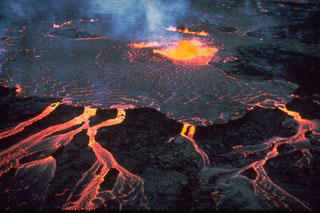Report on Kilauea (United States) — 2 August-8 August 2006
Smithsonian Institution / US Geological Survey
Weekly Volcanic Activity Report, 2 August-8 August 2006
Managing Editor: Sally Sennert.
Please cite this report as:
Global Volcanism Program, 2006. Report on Kilauea (United States) (Sennert, S, ed.). Weekly Volcanic Activity Report, 2 August-8 August 2006. Smithsonian Institution and US Geological Survey.
Kilauea
United States
19.421°N, 155.287°W; summit elev. 1222 m
All times are local (unless otherwise noted)
A 4-hectare (10-acre) area of the lava delta at Kilauea's East Lae'apuki collapsed into the ocean on 30 July. The collapse represented less than 15% of the delta's total area.
During 2-8 August, lava from the PKK lava tube flowed into the ocean at two entries on the SE flank, East Lae`apuki and about 3.5 km E at East Ka`ili`ili. Tilt at the Pu`u `O`o cone displayed a saw tooth pattern and tremor remained at a moderate level.
Geological Summary. Kilauea overlaps the E flank of the massive Mauna Loa shield volcano in the island of Hawaii. Eruptions are prominent in Polynesian legends; written documentation since 1820 records frequent summit and flank lava flow eruptions interspersed with periods of long-term lava lake activity at Halemaumau crater in the summit caldera until 1924. The 3 x 5 km caldera was formed in several stages about 1,500 years ago and during the 18th century; eruptions have also originated from the lengthy East and Southwest rift zones, which extend to the ocean in both directions. About 90% of the surface of the basaltic shield volcano is formed of lava flows less than about 1,100 years old; 70% of the surface is younger than 600 years. The long-term eruption from the East rift zone between 1983 and 2018 produced lava flows covering more than 100 km2, destroyed hundreds of houses, and added new coastline.
Sources: The Honolulu Advertiser, US Geological Survey Hawaiian Volcano Observatory (HVO)

